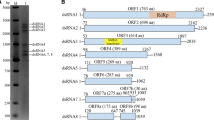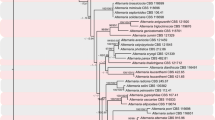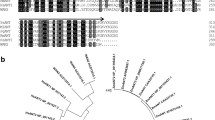Abstract
Strains of the Japanese pear pathotype of Alternaria alternata were screened for double-stranded RNAs (dsRNAs). Four strains had several dsRNAs; strain N18 was associated with several dsRNAs and had impaired growth phenotypes such as irregular mycelium and abnormal pigmentation. We isolated dsRNA-cured isolates from strain N18 by single-conidium isolation. The dsRNA-cured isolates had recovered normal growth and pigmentation. Enlarged vesicles were observed in mycelial cells of the original dsRNA-carrying N18 strain. DAPI nuclear staining revealed regression of the nuclei in dsRNA-carrying N18 cells. These results indicate that the dsRNAs might have negative effects, such as apoptosis-like cell death, on the host fungus.




Similar content being viewed by others
References
Aoki N, Moriyama H, Kodama M, Arie T, Teraoka T, Fukuhara T (2009) A novel mycovirus associated with four double-stranded RNAs affects host fungal growth in Alternaria alternata. Virus Res 140:179–187
Chiba S, Salaipeth L, Lin YH, Sasaki A, Kanematsu S, Suzuki N (2009) A novel bipartite double-stranded RNA mycovirus from the white rot fungus Rosellinia necatrix: molecular and biological characterization, taxonomic considerations, and potential for biological control. J Virol 83:12801–12812
Egusa M, Ochi H, Tsuge T, Otani H, Kodama M (2009) Identification of putative defense-related genes in Japanese pear against Alternaria alternata infection using suppression subtractive hybridization and expression analysis. J Gen Plant Pathol 75:119–124
Ghabrial SA (1998) Origin, adaptation and evolutionary pathways of fungal viruses. Virus Genes 16:119–131
Hammond TM, Andrewski MD, Roossinck MJ, Keller NP (2008) Aspergillus mycoviruses are targets and suppressors of RNA silencing. Eukaryot Cell 7:350–357
Hayashi N, Tsuge T, Kobayashi H, Nishimura S (1988) The presence of double-stranded RNAs in Alternaria alternata Japanese pear pathotype and their participation in AK-toxin productivity. Ann Phytopathol Soc Jpn 54:250–252
Hillman BI, Suzuki N (2004) Viruses of the chestnut blight fungus, Cryphonectria parasitica. Adv Virus Res 63:423–472
Kanematsu S, Arakawa M, Oikawa Y, Onoue M, Osaki H, Nakamura H, Ikeda K, Kuga-Uetake Y, Nitta H, Sasaki A, Suzuki K, Yoshida K, Matsumoto N (2004) A reovirus causes hypovirulence of Rosellinia necatrix. Phytopathology 94:561–568
Marek SM, Wu J, Glass NL, Gilchrist DG, Bostock RM (2003) Nuclear DNA degradation during heterokaryon incompatibility in Neurospora crassa. Fungal Genet Biol 40:126–137
Morris TJ, Dodds JA (1979) Isolation and analysis of double-stranded RNA from virus-infected plant and fungal tissue. Phytopathology 69:854–858
Nuss DL (2005) Hypovirulence: mycoviruses at the fungal–plant interface. Nat Rev Microbiol 3:632–642
Polashock JJ, Hillman BI (1994) A small mitochondrial double-stranded (ds) RNA element associated with a hypovirulent strain of the chestnut blight fungus and ancestrally related to yeast cytoplasmic T and W dsRNAs. Proc Natl Acad Sci USA 91:8680–8684
Sasaki A, Kanematsu S, Onoue M, Oyama Y, Yoshida K (2006) Infection of Rosellinia necatrix with purified viral particles of a member of Partitiviridae (RnPV1–W8). Arch Virol 151:697–707
Shepherd HS (1988) Virus like particles in tentoxin-producing strains of Alternaria alternata. J Virol 62:3888–3891
Tanaka A, Shiotani H, Yamamoto M, Tsuge T (1999) Insertional mutagenesis and cloning of the genes required for biosynthesis of the host-specific AK-Toxin in the Japanese pear pathotype of Alternaria alternata. Mol Plant Microbe Interact 12:691–702
Zabalgogeazcoa I, Petrunak D, Christ BJ, Gildow FE (1997) Unencapsidated double-stranded RNA associated with membrane vesicles in isolates of Alternaria solani. Mycol Res 101:604–608
Acknowledgments
We thank Prof. T. Tsuge (Nagoya University), Dr. F. Yasuda (Tottori Prefectural Agriculture and Forest Research Institute), Prof. D. G. Gilchrist (University of California), Prof. J. Hille (University of Groningen), Mr. H. Shiomi (Takii and Co. Ltd.), and Prof. H. Otani (Tottori University) for providing the Alternaria strains. We also thank Prof. T. Arie (Tokyo University of Agriculture & Technology) and Prof. T. Teraoka for their valuable advice. This research was supported in part by Grants-in-Aid for Scientific Research (No. 20580045) from the Ministry of Education, Culture, Sports, Science, and Technology of Japan and from the Industrial Technology Development Organization (No. 08C46503c).
Author information
Authors and Affiliations
Corresponding author
Rights and permissions
About this article
Cite this article
Fuke, K., Takeshita, K., Aoki, N. et al. The presence of double-stranded RNAs in Alternaria alternata Japanese pear pathotype is associated with morphological changes. J Gen Plant Pathol 77, 248–252 (2011). https://doi.org/10.1007/s10327-011-0315-0
Received:
Accepted:
Published:
Issue Date:
DOI: https://doi.org/10.1007/s10327-011-0315-0




